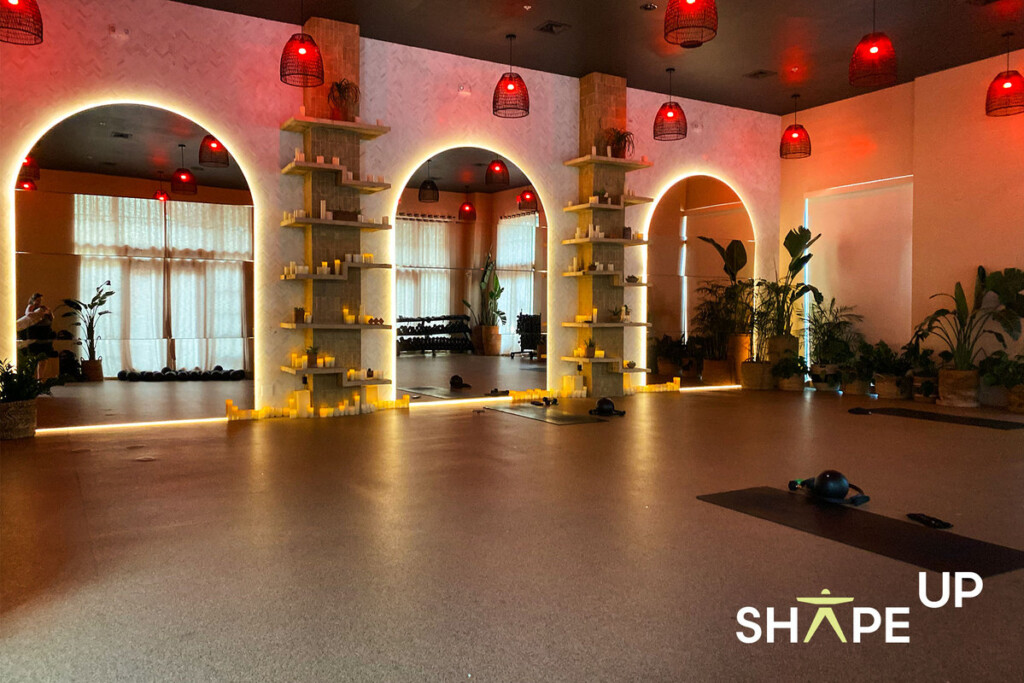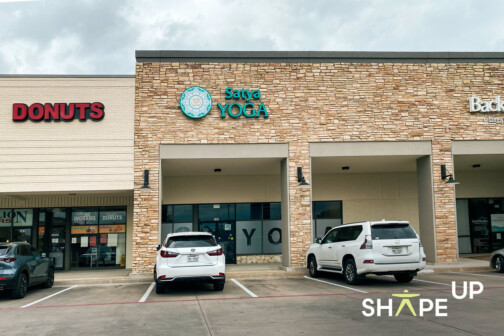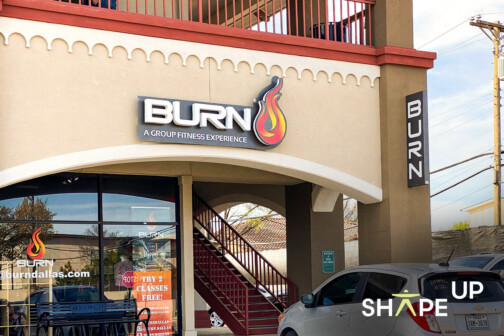When my mat Pilates class at Jungle started with everyone in the child’s pose, I foolishly thought, “oh, this will be easy.” The last class I’d taken at the boho-chic Bishop Arts studio, a HIIT session, had been rough. But this seemed different. Those were, as they say, my famous last words.
Not even 10 minutes later, I was on my back, holding my body in a bridge and squeezing a ring with my knees. My legs buckled almost uncontrollably. “Oh, no,” I whispered to myself. “I was wrong.”
The Monday evening class was packed. I unfurled my mat near the back of the studio (note: you do not need to bring your own mat to this class) and grabbed the equipment. This session requires more props than any other class I’ve taken in Dallas. We had towels to place under our knees, an exercise ring, a set of weights, a resistance band, and, finally, a rubber ball.
We used the ring the most. It was about a foot in diameter with these sort-of handles on either side. At the beginning of class, we put it between our knees and squeezed in small, killer isometric movements while lying down. We held the ring between our ankles and did leg lifts in a sneaky core exercise. I couldn’t control the ring here, so I just dropped it. Later, we held the ring in our hands and did squeeze pulses while bending into various lunges. We also used the ring to active stretch our hamstrings at the end. I liked the ring—it was a simple, yet effective and easily modifiable, tool to add an extra component to our movement.
However, this class was hard. All the ab work at the beginning was nearly impossible for me. I was almost glad when we got to the lunging and squats. Those at least I could do. Many of our lunge movements were in reverse, to mimic the megaformer exercises in reformer Pilates, just with the security of flat, stationary ground. An unexpected benefit of all the lunging was that I got an awesome heel cord stretch in. During the squats, we used the weights to do bicep curls. We could also go up on our toes for an added challenge here.
Like most Pilates classes, and even barre, this one focused on isometric movements, which force an isolated group of muscles to engage, and lots of repetitions. We also mixed in cardio with bouncing, jogging, and jumping jacks. These were used to “reset” between exercises. We also used the resistance bands for cardio—wrapping them around our wrists and pumping our arms like we were sprinting. I liked this a lot. It was a good workout, and it was different. In most other classes I’ve taken, we wrapped the bands around our thighs to go into a bridge, which usually threatens to cut off your circulation if your thighs aren’t stick thin.
Many exercises blurred together as I struggled through. Some, like this godforsaken exercise called a Pilates burpee, I blacked out of my memory the second it was over. Burpees in general are difficult for anyone with mobility issues. This one was just unfair.
Throughout, the instructor was good about assigning an exercise, then almost immediately announcing an easier version. For example, instead of using downward-facing dog to reset between activities, we could use tabletop. Sometimes, though, she’d announce a modification after she noticed one of us doing that modification. This isn’t unusual—many instructors across Dallas do this—but it’s always frustrated me. It feels like they’re trying to make us feel better about not being able to do the assigned exercise. That’s not really fair to the instructors, however, and I’d rather them do this than not at all.
One thing I really liked about this instructor was that periodically, she told us to stop and drink water. Not every instructor does this. I’ve often gotten dehydrated in class because I forgot to drink. Building in water breaks, in my opinion, is a responsible move.
We didn’t use the rubber ball until the very end. We put under our backs to do crunches. Normally, the ball helps me crunch, but at this point, I was so tired I couldn’t even hold my neck up, so I ditched the ball. It went rolling across the room.
This class was a very thorough workout, but I relied on adrenaline to get through. When it ended, my legs were wobbly as I returned my equipment. I could barely lift my arms up put my three-pound weights back on the rack. When I got to my car, I wasn’t sure I had the strength to drive home. I gingerly drove down I-35, disgruntling motorists all around me.
My body hurt for days after. Part of it was general soreness in my thighs and arms—it was a thoroughly difficult workout, after all. But my shoulders and back hurt, too. My barely existent abs didn’t smart at all. This, I’d attribute to all the modifications I made. If you’ve ever had crutches, you know that the rest of your body often aches because it’s overcompensating for the out-of-service leg or ankle, what have you. Without proper instruction, modifications do the same thing. I am not blaming anyone besides myself for my achy back, but I think some studios are better than others at making modifications and explaining how not to overextend yourself. I wish all studios could be on the same page.
Final Thoughts
Aesthetics
One of the things I love about Jungle is how beautiful the studio is. The earthy tones, arches, plants, and candles put you in a calm mood, no matter how much the workout makes you want to die. The place felt the same as the last time I visited, but this time the curtains were closed, which made the studio feel smaller, somehow. The front desk moved to a nook, freeing up the main floor. And the entrance has moved to next to Casablanca, with cute light-up Jungle sign that’s begging for an Instagram post, which I happily obliged.
Difficulty
This class was hard. I could attempt most of the movements, but I had to modify almost everything. I often couldn’t do as many reps as everyone else. Or I had to do something completely different—like when we did these running pushups and I dropped to my knees. Glances around the room showed me that many others were in the same boat.
Accessibility
I often lean towards mat-based classes, like this one, because they are easier to accommodate different abilities than ones with machines. What I do on the mat is strictly what I can do, and I’m less likely to get overwhelmed by the machine. I could modify most of the exercises here, and the instructor often announced modifications. That said, I am more mobile than many with disabilities. I am more mobile than I once was, even. And I don’t think this class is doable for everyone.
The Cost of It All
Pricing hasn’t changed for Jungle’s workouts. A one-off class is $25. If you’re new, you can get your first class for $15. Bishop Arts residents can also get exclusive deals. For the rest of us, passes begin at $59 for a week, memberships start at $99, and class packs are $115-plus.
Would I go back?
Not to this class, but I would recommend it to anyone who enjoys Pilates.
Get the AtHome Newsletter
Author






